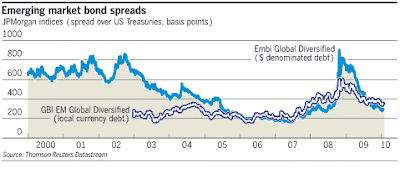Pensions Pouring Money Into EM Debt

Steve Johnson of the Financial Times report that pensions pour into emerging market debt:
US pension funds are poised to pour almost $100bn (£62bn, €70bn) into emerging market debt in the next five years, according to JPMorgan.
The impending buying spree will be augmented by strong flows from central banks desperate to diversify out of the dollar, industry figures believe, bolstering the ongoing rally in emerging market bonds and potentially pushing yields relative to US Treasuries to a record low.
“We expect a long-term structural bid [from US pension funds] for emerging market debt,” said Will Oswald, global head of emerging market quantitative strategy at JPMorgan.
Jerome Booth, head of research at Ashmore Investment Management, an EM debt specialist, said: “Pension fund consultants are being inundated with requests.”
Demand is being driven by the 2006 Pension Protection Act, which came into force in 2008 and compels US corporate pension funds to discount their future liabilities using a market interest rate, rather than using their expected rate of return on their assets, as public sector funds can.
This is pushing corporate funds to sell equities and buy bonds, as they seek assets whose value moves in line with the new discount rate. In the 10 months to August 2009, US corporate pension funds increased their allocation to bonds from 32.4 to 38.4 per cent, according to Towers Watson, with further buying expected this year.
JPMorgan said there were signs much of this would go into emerging market debt as pension funds sought the higher yields and longer duration of the EM universe, where 30-year bonds are commonplace, allowing pension funds to hedge liabilities more accurately.
Inflows are likely to be bolstered further by the benchmark sovereign bond index, JPMorgan Embi Global Diversified, attaining investment grade status earlier this month.
According to JPMorgan, corporate US pension funds currently have just 0.3 per cent of their assets in EM debt. However, funds that have rebalanced have typically moved to a 5-7 per cent allocation, a figure Mr Oswald argued was “realistic” across the whole sector within three to five years.
With corporate US schemes holding $1,400bn of assets, this implies $90bn of fresh investment, a significant sum compared to the $300bn currently benchmarked against the JPMorgan indices.
Mr Booth added: “The Pension Protection Act is motivating a lot of corporate plans in the US. They can increase their duration by a year and their yield by 130 basis points by putting more money into EM debt. And the index becoming investment grade means it will be seen as much more investable by a wide range of institutions.”
Robin Creswell, managing principal of Payden & Rygel Global, saw potential for “substantial demand” from pension funds, as a result of improving economic fundamentals across emerging markets and the fact that yield spreads are above 2007 levels, despite EM debt being investment grade.
EM debt is also receiving a shot in the arm from Asian central bank reserve diversification and petrodollar recycling, according to Mr Oswald. “We continue to get enquiries from central banks.”
Mr Oswald saw the potential for a bubble to emerge, but Mr Booth argued supply would rise to meet demand and that yields on local currency EM debt had the potential to fall to below those of US Treasuries.
Whenever I read that pension fund consultants are "being inundated with requests," my antennas go up, as does the hair behind my neck! A potential bubble in emerging market debt? Highly likely but we will find out soon enough when market expectations of Fed rate hikes abruptly shift in Q1 2010. Till then, money will keep pouring into all risk assets, including EM debt.
Comments
Post a Comment